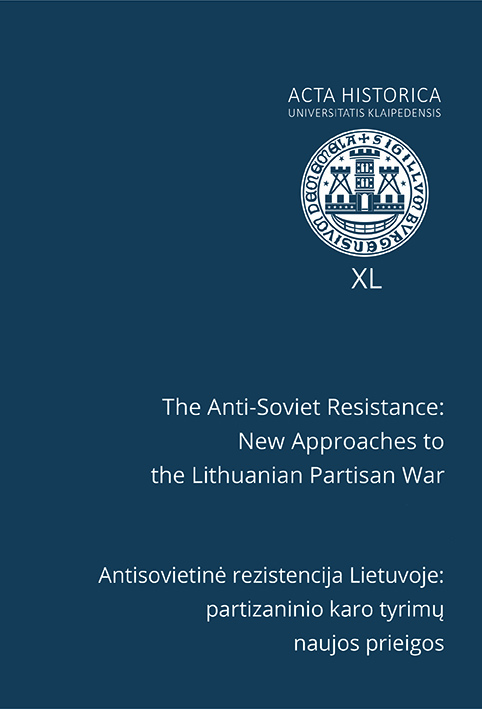Volume 40 (2020): The Anti-Soviet Resistance: New Approaches to the Lithuanian Partisan War = Antisovietinė rezistencija Lietuvoje: partizaninio karo tyrimų naujos prieigos, June 2020

Order by:
Pub. online: 15 Jun 2020
Type: Editorial Note
 Open Access
Open Access
Journal:
Acta Historica Universitatis Klaipedensis
Volume 40 (2020): The Anti-Soviet Resistance: New Approaches to the Lithuanian Partisan War = Antisovietinė rezistencija Lietuvoje: partizaninio karo tyrimų naujos prieigos, pp. 5–6
Pub. online: 15 Jun 2020
Type: Introduction
 Open Access
Open Access
Journal:
Acta Historica Universitatis Klaipedensis
Volume 40 (2020): The Anti-Soviet Resistance: New Approaches to the Lithuanian Partisan War = Antisovietinė rezistencija Lietuvoje: partizaninio karo tyrimų naujos prieigos, pp. 7–14
Pub. online: 15 Jun 2020
Type: Introduction
 Open Access
Open Access
Journal:
Acta Historica Universitatis Klaipedensis
Volume 40 (2020): The Anti-Soviet Resistance: New Approaches to the Lithuanian Partisan War = Antisovietinė rezistencija Lietuvoje: partizaninio karo tyrimų naujos prieigos, pp. 15–21
Pub. online: 15 Jun 2020
Type: Article
 Open Access
Open Access
Journal:
Acta Historica Universitatis Klaipedensis
Volume 40 (2020): The Anti-Soviet Resistance: New Approaches to the Lithuanian Partisan War = Antisovietinė rezistencija Lietuvoje: partizaninio karo tyrimų naujos prieigos, pp. 25–67
Abstract
Pub. online: 15 Jun 2020
Type: Article
 Open Access
Open Access
Journal:
Acta Historica Universitatis Klaipedensis
Volume 40 (2020): The Anti-Soviet Resistance: New Approaches to the Lithuanian Partisan War = Antisovietinė rezistencija Lietuvoje: partizaninio karo tyrimų naujos prieigos, pp. 69–95
Abstract
Pub. online: 15 Jun 2020
Type: Article
 Open Access
Open Access
Journal:
Acta Historica Universitatis Klaipedensis
Volume 40 (2020): The Anti-Soviet Resistance: New Approaches to the Lithuanian Partisan War = Antisovietinė rezistencija Lietuvoje: partizaninio karo tyrimų naujos prieigos, pp. 97–139
Abstract
Pub. online: 15 Jun 2020
Type: Source Publication
 Open Access
Open Access
Journal:
Acta Historica Universitatis Klaipedensis
Volume 40 (2020): The Anti-Soviet Resistance: New Approaches to the Lithuanian Partisan War = Antisovietinė rezistencija Lietuvoje: partizaninio karo tyrimų naujos prieigos, pp. 143–377
Pub. online: 15 Jun 2020
Type: Book Review
 Open Access
Open Access
Journal:
Acta Historica Universitatis Klaipedensis
Volume 40 (2020): The Anti-Soviet Resistance: New Approaches to the Lithuanian Partisan War = Antisovietinė rezistencija Lietuvoje: partizaninio karo tyrimų naujos prieigos, pp. 381–385